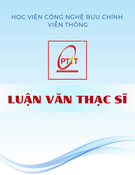8/26/2012
Ch. 3 DAS DATA ACQUISITION SYSTEMS
• DAS overview • Measurement, sensors, transducers • Conditioners, các bộ chuẩn hóa tín hiệu • MUX, S&H, ADCs • Microcontrollers and Data Processing • Database • Case studies: monitoring systems
1
Ch3 - DAS
3.1. DAS Overview • Define:
– Data Acquisition System: The system for acquiring data (status, metric information) from industrial processes (or environment) then update to database, one of importance part of a SCADA, DCS…
– The collection of sensors and communication links
to sample or collect and then return data to a central location for further processing, display, or archiving. • Structure: next
2
Ch3 - DAS
1
8/26/2012
3.1. DAS Overview
3
Ch3 - DAS
3.1. DAS Overview • Student’s define for structure:
– Object: – Sensor: – Conditioner: WorkBench, LabView – MUX: – S&H: – ADC: – Embedded System – Computer Desktop: database and networking
4
Ch3 - DAS
2
8/26/2012
3.1. DAS Overview • Operate: – Process – Sensor – Conditioner – MUX – S&H and ADC – ES – Database system
5
Ch3 - DAS
3.1. DAS Overview
• Classification:
– The number of data elements/points, – Distance/wide area – Rate of signal – Address of application and type of information:
• Industrial fields: level, flow, temperature, pressure,… in cement, paper, textile, steel mill, mechanical factories…
• Civil engineering: dams, bridges, underground/ under- water constructions, high building… => constructions supervision system
6
• Environmental supervision system
Ch3 - DAS
3
8/26/2012
3.1. DAS Overview
• Transportation: Vehicles, ship, aero plane: velocity,
accelerate, gasoline ratio, safety equipment, Navigation…; Traffic signals
• Bio-medicine: Cardiograph, Monitoring, smart garden and growth
7
• Defense: DGPS, • Entertainment: • Smart house: temperature, lighting, air conditioning (heating/ freezing), plant watering, auto-answering, smart cooking… iBMS
Ch3 - DAS
3.1. DAS Overview • Questions and Answers • Student’s examples
8
Ch3 - DAS
4
8/26/2012
3.2 Measurement • Sensor Defines:
(A device that responds to a physical stimulus in real world (heat, light, sound, pressure, motion, flow, and so on), and produces a corresponding electrical signal)
– Là thiết bị nhận các tín hiệu vật lý từ thế giới thật (nhiệt, ás, âm thanh, áp suất…), tạo ra các tín hiệu điện tương ứng.
– Là một phần của thiết bị đo, nó đáp ứng trực tiếp ứng với sự thay đổi của môi trường (The part of a measuring instrument which responds directly to changes in the environment)
• Transducers are ENERGY CONVERTERS or
MODIFIERS – Là thiết bị thay đổi năng lượng từ dạng này sang dạng khác
(A device for converting energy from one form to another)
– For example, a thermocouple transduces heat energy into electrical energy
• (Tuy nhiên trong thực tế thường hay coi là 1)
9
Ch3 - DAS
3.2.1. Sensor characteristics
• Transducers, sensors và phép đo • Calibration, interfering và thay đổi tín hiệu vào • Static sensor characteristics • Dynamic sensor characteristics
10
Ch3 - DAS
5
8/26/2012
Measurement:
11
Ch3 - DAS
Measurements: • Mô hình đo lường đơn giản:
• X liên hệ với phép đo trong một số phương pháp đã biết (i.e.,
measuring mass)
– Giá trị quan sát được X đọc được từ đối tượng đo
– Sensor phát ra tín hiệu thay đổi và được xử lý theo nhiều kiểu, truyền dẫn hoặc hiển thị – Trong ví dụ trên, tín hiệu đo được đưa qua bộ hiển thị và
đưa đến thiết bị đo. • Phép đo (Measurement)
12
– Là quá trình so sánh đại lượng chưa biết với giá trị chuẩn có cùng đơn vị (đo độ dài, khoảng cách) hoặc giá trị chuẩn của nhiều các đại lượng liên quan (đo vận tốc, gia tốc)
Ch3 - DAS
6
8/26/2012
Khắc độ (Calibration)
• Là quan hệ giữa đại
lượng đo vật lý (X) và giá trị tín hiệu (S)
• Sensor hoặc thiết bị đo
được khắc độ bởi việc thu thập các tín hiệu đã biết.
13
Ch3 - DAS
Additional inputs • Nhiễu đầu vào (Y)
– Nhiễu tác động vào sensor sẽ tạo ra sự xếp chồng tuyến tính với giá trị đo X – Xếp chống tuyến tính là: S(aX+bY)=aS(X)+bS(Y)
• Modifying inputs (Z)
– Là việc thay đổi hành vi
14
của sensor => thay đổi đặc tính. – Ví dụ nhiệt độ là 1 tín hiệu vào thường thay đổi
Ch3 - DAS
7
8/26/2012
Sensor Characteristics • Đặc tính tĩnh: (Static characteristics)
– Các thuộc tính của hệ thống sau các hiệu ứng quá độ sẽ ổn định với các
đặc tính tĩnh: • Accuracy • Discrimination - độ phân biệt hay còn gọi độ phân ly • Precision • Errors • Drift • Sensitivity • Linearity • Hysteretic
– The properties of the system transient response to an input
• Zero order systems • First order systems • Second order systems
15
• Dynamic characteristics
Ch3 - DAS
Accuracy, discrimination and precision
đo so với giá trị thực
• Accuracy is the capacity of a measuring instrument to give RESULTS close to the TRUE VALUE of the measured quantity – Độ chính xác (accuracy) được xác định bằng độ lệch của 1 tập các phép
– Độ chính xác/sai số được thể hiện giá trị tuyệt đối và tương đối ABSOLUTE ERROR = RESULT – TRUE VALUE RELATIVE ERROR = ABS ERROR/TRUE VALUE (%) • Resolution (Discrimination) is the minimal change of the input necessary to produce a detectable change at the output – Độ phân ly: DISCRIMINATION hay RESOLUTION – When the in/discrimination is from zero, it is called THRESHOLD
(ngưỡng)
16
Ch3 - DAS
8
8/26/2012
Precision (độ lặp lại)
• Là khả năng của thiết bị cho ra cùng 1 giá trị khi lặp lại phép đo cùng 1 đại lượng trong cùng 1 điều kiện: – Độ lặp lại được hiểu là sự nhất quán giữa các lần đo liên tiếp cùng 1 đại lượng, nó không nói lên giá trị đó gần với giá trị thực.
– Precision là điều cần chứ không là điều kiển đủ để đánh giá độ chính xác
• 2 thuật ngữ liên quan mật thiết đến precision
• được thực hiện trong khoảng thời gian dài, hoặc • do các người khác nhau thực hiện hoặc • dùng các dụng cụ đo khác nhau hoặc • trong các phòng thí nghiệm khác nhau
17
– Repeatability: Độ lặp lại của 1 tập các phép đo trong 1 thời gian ngắn – Reproducibility: là độ lặp lại của 1 tập các phép đo nhưng:
Ch3 - DAS
Example
• Phóng tiêu (DART)
– Độ phân ly – Kích thước của vùng được tạo bởi phi tiêu – Which shooter is more accurate? – Which shooter is more precise?
18
Ch3 - DAS
9
8/26/2012
Accuracy and errors • Sai số hệ thống: (Systematic Errors) – Là nguyên nhân từ nhiều yếu tố khác nhau – Do các đại lượng khác can thiệp vào hoặc các sự biến đổi
khác (i.e., temperature)
– Trôi mạch điện tử, các kết cấu cơ, hóa (i.e., changes in chemical structure or mechanical stresses)
– Quá trình đo làm thay đổi đối tượng đo. (i.e., loading errors, electro-mechanic Voltmeter)
– Khi truyền dẫn làm thay đổi tín hiệu (i.e., suy giảm, méo) – Sai số chủ quan (i.e., quan sai: sai do mắt nhìn, quan niệm của mỗi người)
19
– Sai số hệ hệ thống có thể được bù trừ bằng các phương pháp khác nhau (như phản hồi, lọc)
Ch3 - DAS
Accuracy and errors: • Sai số ngẫu nhiên:
– Còn được gọi là nhiễu: tín hiệu không chứa thông tin đo – Sai số ngẫu nhiên thực sự (ồn trắng - white noise) có phân bố Gauss
• Độ lặp lại của chính đối tượng đo (i.e., height of a rough surface) • Nhiễu môi trường (i.e., background noise picked by a microphone) • Nhiễu đường truyền (i.e., 60Hz)
– Nguồn nhiễu ngẫu nhiên:
– Tỷ số tín hiệu/nhiễu nhỏ. Thường thì SNR phải >>1 – Khi biết đặc tính của tín hiệu thì có thể tách ra khỏi nền
20
nhiễu với điều kiện SNR>>1 (i.e., understanding speech in a loud environment)
Ch3 - DAS
10
8/26/2012
Example: systematic and random errors
21
Ch3 - DAS
Các đặc tính tĩnh khác:
– The maximum and minimum value of the physical variable that can be
measured (i.e., -40F/100F in a thermometer)
– Output range can be defined similarly
• Input range:
– Độ dốc của đường đặc tính y=f(x)
• 1 sensor lý tưởng sẽ có độ nhạy lớn và ổn định – Sai số liên quan đến độ nhạy: bão hòa và vùng chết
• Độ nhạy (Sensitivity)
– Là sự gần đúng của đặc tính thực so với đường thẳng mẫu (i.e., đặc tính
lý thuyết khớp với giá trị bình phương cực tiểu)
• Độ tuyến tính: Linearity
– Đặc tính của sensor cần phải đơn điệu
• Tính đơn điệu (Monotonicity)
– Giá trị ra khác nhau khi giá trị vào giống nhau nhưng ở 2 chiều tăng và
giảm (i.e., magnetization in ferromagnetic materials)
• Backslash: hystheresis caused by looseness in a mechanical joint
22
• Trễ của đặc tính: Hysteretic
Ch3 - DAS
11
8/26/2012
Dynamic characteristics
• Đáp ứng của sensor khi đại lượng vào biến thiên khác
với đại lượng vào ổn định
• Là do có các phần tử kho năng lượng – Quán tính (Inertial): masses, inductances – Capacitances: electrical, thermal
• Đặc tính động được xác định bởi việc phân tích các đáp ứng của sensor với một họ các đại lượng vào khác nhau về dạng sóng – Impulse, step, ramp, sinusoidal, white noise…
23
Ch3 - DAS
Các mô hình động (Dynamic models)
• Đáp ứng động của sensor (typically) được
coi như tuyến tính – Như vậy, có thể mô hình hóa bởi phương trình vp
tuyến tính hệ số hằng
- Thực tế, những mô hình này giới hạn về dạng ptvp zero, first and second order. Những mô hình cao hơn ít dùng.
24
Ch3 - DAS
12
8/26/2012
Dynamic models • Những mô hình động thường được phân tích theo biến đổi Laplace, biến đổi ptvp thành đa thức – Biểu diễn Laplace như 1 dạng mở rộng của
Fourier transform • Phân tích Fourier được giới hạn cho sinus signals
– x(t) = sin(ωt) = e-jωt
– x(t) = e-σtsin(ωt) = e-(σ +jω)t
25
• Phân tích Laplace cũng có thể được thực hiện theo kiểu hàm mũ
Ch3 - DAS
Tham khảo: Laplace Transform (review)
• The Laplace transform of a time signal y(t) is
denoted by
L[y(t)] = Y(s)
• The real component σ defines the real exponential behavior • The imaginary component defines the frequency of oscillatory
behavior
– The s variable is a complex number s=σ+jω
• The fundamental relationship is the one that
concerns the transformation of differentiation
26
Ch3 - DAS
13
8/26/2012
Laplace Transform (review)
• Other useful relationships are
27
Ch3 - DAS
The Laplace Transform (review)
– G(s) is called the transfer function of the sensor
• Applying the Laplace transform to the sensor model yields
• The position of the poles of G(s) -zeros of the denominator-
28
in the s-plane determines the dynamic behavior of the sensor such as – Oscillating components – Exponential decays – Instability
Ch3 - DAS
14
8/26/2012
Pole location and dynamic behavior
29
Ch3 - DAS
Zero-order sensors
• Quan hệ giữa Input & output
bởi phương trình dạng: – Zero-order là dạng đáp ứng
• Không trễ • Bandwidth không xác định • Sensor chỉ thay đổi biên độ tín hiệu
vào
mong muốn của sensor
– Zero-order systems: không chứa phần tử kho điện
30
– Example of a zero-order sensor • A potentiometer used to measure linear and rotary displacements – Mô hình này không thích hợp với hệ đo dịch chuyển biến thiên nhanh
Ch3 - DAS
15
8/26/2012
First-order sensors • Quan hệ giữa Inputs &
outputs bởi ptvp bậc nhất – First-order sensors chứa 1 phần tử kho điện và một phần tử tiêu tán
– A biên độ của bước nhảy – k (=1/a0) là hs khuếch đại tĩnh, được xác định bởi đáp ứng tĩnh – τ (=a1/a0) là hằng số thời gian được
xác định bởi đáp ứng động
– Đáp ứng bước nhảy: • y(t) = Ak(1-e-t/τ)
• y(t) = Akt - Akτu(t) + Akτe-t/τ
– Ramp response
• Thường được mô tả bởi biểu đồ
biên-pha
31
– Frequency response
Ch3 - DAS
First-order sensor response
32
Ch3 - DAS
16
8/26/2012
Example of a first-order sensor
• A mercury thermometer immersed into a fluid – What type of input was applied to the
• C: thermal capacitance of the mercury • R: thermal resistance of the glass to heat
transfer
• θF: temperature of the fluid • θ(t): temperature of the thermometer
sensor? – Parameters
33
– The equivalent circuit is an RC network
Ch3 - DAS
Example of a first-order sensor
34
Ch3 - DAS
17
8/26/2012
3.2.2. Nguyên lý sensor
• Phân loại sensors • Sensors cơ • Sensors nhiệt • Sensors hóa
35
Ch3 - DAS
Phân loại sensors:
• Sensors được phân loại theo các cách sau: – Power supply requirements: Passive and active – Nature of the output signal: Digital and analog – Measurement operational mode: Deflection and
null modes
– Input/output dynamic relationships: Zero, first,
second order, etc.
– Measurand: Mechanical, thermal, magnetic,
radiant, chemical
– Physical measurement variable: Resistance,
inductance, capacitance, etc.
36
Ch3 - DAS
18
8/26/2012
Passive and active sensors
• Thụ động hay tự sinh (Passive or self-generating)
• Output signal power comes from the stimulus
– Đáp ứng là tín hiệu điện, phát trực tiếp khi có kích thích từ bên ngaòi, không cần nguồn điện cấp
• Thermocouple • Piezoelectric sensors
– Examples:
• Chủ động hay điều chế (Active or modulating)
• Output signal power comes from the power supply
– Các sensor này, khi hoạt động cần có nguồn cấp ngoài hoặc tín hiệu kích thích từ ngoài
• Thermistors • Chemo-resistors
37
– Examples:
Ch3 - DAS
Analog and digital sensors
• Analog sensors:
– Cho ra tín hiệu liên tục cả về biên độ và thời gian hoặc không gian – Hầu hết các đối tượng vật lý, theo
displacement, light intensity
tự nhiên, là tín hiệu analog. • Examples: Temperature,
• Digital sensors:
• Digital signals are more repeatable,
reliable and easier to transmit – Examples: Shaft encoder, contact
– Đưa ra dạng tín hiệu là rời rạc, các bước hoặc trạng thái 1/0
38
switch
Ch3 - DAS
19
8/26/2012
Operational modes
• Chế độ so lệch (Deflection mode)
– Sensor hay thiết bị đo tạo ra đáp ứng là độ lệch hay sự sai khác với giá trị ban đầu
– Độ lệch tỷ lệ với đại lượng đo • Chế độ cân bằng (Null mode)
• The influence and measurand are balanced (typically through feedback) until they are equal but opposite in value, yielding a null measurement
– Sensor hoặc thiết bị đo tạo ra sự đối trọng với đối tượng đo
39
– Null mode instrumentation can produce very accurate measurements, but are not as fast as deflection instruments
Ch3 - DAS
Mechanical measurands
• Displacement
– Resistive sensors – Capacitive sensors – Inductive sensors
• Force and acceleration
– Strain gauges – Cantilever beam-based sensors
40
Ch3 - DAS
20
8/26/2012
Resistive displacement sensors
• A resistance with a movable contact (a potentiometer) may be
used to measure linear or rotational displacements – A known voltage is applied to the resistor ends – The contact is attached to the moving object of interest – The output voltage at the contact is proportional to the displacement
– Non-linearities as a result of loading effects – Resolution due to limited number of turns per unit distance – Contact wear as a result of frictions
41
• Notes
Ch3 - DAS
Capacitive displacement sensors
d is the separation between the plates, A is the area of the plates, ε0 is the permitivity of air and εr is the relative permitivity of the dielectric • A moving object is attached to the dielectric or the plates to generate capacitance changes
• The capacitance of a parallel plate capacitor is
Notes
- Variable distance (d) sensors operate over a range of a few millimeters - Cross-sensitivity to temperature and humidity (specially if the dielectric is air) - Capacitive sensors are also commonly used to measure pressure
“Condenser” microphones measure changes in air pressure of incoming sound waves
42
Ch3 - DAS
21
8/26/2012
Sensor đo dịch chuyển kiểu điện cảm
• Biến áp vi sai biến đổi tuyến tính (Linear
• Primary coil voltage: VSsin(ωt) • Secondary coil induced emf: V1=k1sin(ωt+ϕ)
and V2=k2sin(ωt+ϕ)
• Induced emf – electromotve force, suất điện
động cảm ứng
– k1 và k2 phụ thuộc vào sự lắp đặt vị trí giữa sơ
và thứ cấp.
– Khi lõi (core) nằm giữa, k1=k2 => VOUT=V1-V2
= 0
• Khi lõi dịch chuyển 1 lượng x, k1≠k2 =>
VOUT=(k1-k2)sin(ωt+ϕ)
• Dịch lên hay xuống được xác định bởi pha của
VOUT
43
Variable Differential Transformer - LVDT) – Sự dịch chuyển của lõi từ làm thay đổi hỗ cảm của 2 cuôn thứ cấp (phụ thuộc vào sơ cấp)
Ch3 - DAS
Inductive displacement sensors (cont)
• LVDT Characteristics
– Typical LVDTs run at 5V, 2kHz – LVDTs can measure from mm down to μm – Due to small variations in the windings, a small
residual voltage appears at the output when the coil is in the central position
• Advantages of the LVDT over other
displacement sensors – No mechanical wear ensures a long life – Complete electrical isolation – DC versions with integrated oscillators are
available
44
Ch3 - DAS
22
8/26/2012
Điện trở lực căng (Strain gauges)
• Strain gauges thay đổi R khi lực căng thay đổi
(piezo-resistive effect) – Strain is a fractional change (ΔL/L) in the
dimensions of an object as a result of mechanical stress (force/area)
– The resistance R of a strip of material of length L,
cross-section A and resistivity ρ is R=ρL/A – Differentiating, the gauge factor G becomes
45
Ch3 - DAS
46
Ch3 - DAS
23
8/26/2012
Strain gauges • Cấu tạo và sử dụng:
– Thường, strain gauges bao gồm lá kim loại (foil) hoặc dây wire được phủ bởi 2 lá cách điện (polyimide)
– Gauge được dán vào vật bằng keo dán – Các đường dẫn dọc được sắp đặt theo chiều
của lực căng.
– Độ nhậy của sự biến dạng ngang có thể
được bỏ qua.
– Nhiệt độ ảnh hưởng nhiều đến gauges bán
dẫn
• Để bù T, thường hay đặt thêm một
“dummy” gauges có cùng hiệu ứng T nhưng không cho chịu lực, bù vi sai.
– Sự thay đổi R là rất nhỏ
• Strain gauges are almost invariable used in a
Wheatstone bridge
47
• Chú ý:
Ch3 - DAS
Force and acceleration sensors
– The coupled-double-beam load cell
• Dumb-bell cut-out provides areas of
maximum strain for the gauges
• Cantilever beam bends in an S-shape – This induces both compressive and tensile strains that can be easily measured in a bridge arrangement
• Force sensors
– Spring-mass-damper accelerometer • Covered in the previous lecture – Cantilever-beam with strain gauges
• A seismic mass is attached to the end of
the cantilever
– Dampening is usually performed with viscous fluids or permanent magnets
48
• Acceleration sensors
Ch3 - DAS
24
8/26/2012
Temperature sensors
• Thermo resistive sensors
– Resistive Temperature Devices (RTD) – Thermistors
• Thermoelectric sensors
– The Seebeck effect – The Peltier effect – Thermocouples
• p-n junction sensors – Covered in the Lab
49
Ch3 - DAS
Thermoresistive sensors
50
Ch3 - DAS
25
8/26/2012
Thermoelectric sensors
• The Seebeck effect
– When a pair of dissimilar metals are joined at one end, and there is a
temperature difference between the joined ends and the open ends, thermal emf is generated, which can be measured in the open ends
• The Peltier effect
– When a current passes through the junction of two different conductors, heat can be either absorbed or released depending on the direction of current flow
• Thermocouples
– Based on the Seebeck effect – Open ends must be kept at a constant reference temperature TREF – A number of standard TCs are used
• These are denominated with different letter codes: T, J, K, S, R…
– i..e, type J (the most popular) is made of Iron and Constantan (Cu/Ni alloy:
57/43)
51
Ch3 - DAS
52
Ch3 - DAS
26
8/26/2012
Chemical sensors
• Conductivity – Metal-oxides – Conducting polymers
• Piezo-electric
– Surface Acoustic Wave – Quartz Crystal Microbalance
53
Ch3 - DAS
Conductivity sensors • Absorption of gases modifies the conductivity of sensing layer •
Sensing layer types
– Metal Oxide
• Typically SnO2 doped with Pt or Pd • Operate a high temperatures (300-5000C) • Temperature-selectivity dependency • Broad selectivity
– Particularly suitable for combustible gases – Conducting Polymers
• Based on pyrrole, aniline or thiophene • Operate at room temperature
• CPs vs MOXs
– CP advantages
• Large number of polymers available with various selectivities • Sensitivity* to wide number of VOCs • Low power consumption • Faster response and recovery times
– CP Limitations
• Cross-sensitivity* to humidity • Lower sensitivity* than MOXs
*By sensitivity here we mean the ability to detect certain VOCs, not
the slope of the calibration curve
54
Ch3 - DAS
27
8/26/2012
Piezo-electric chemical sensors • Piezo-electric effect
– The generation of an electric charge by a crystalline material upon subjecting it to stress (or the opposite) • A typical piezo-electric material is Quartz (SiO2)
– Piezo-electric sensors
• Thin, rubbery polymer layer on a piezo-electric substrate • Sensing principle: mass and viscosity changes in the
sensing membrane with sorption of VOCs
•
Surface Acoustic Wave (SAW)
– AC signal (30-300MHz) applied to interdigitated input
electrode generates a surface (Rayleigh) wave
– Propagation delays to output electrode are affected by
changes in the surface properties
– Phase shifts of the output electrode signal are used as a
response
• Quartz Crystal Microbalance (QMB)
– Also known as Bulk Acoustic Wave (BAW) devices – Device is operated in an oscillator circuit – Changes in the sensing membrane affect the resonant
frequency (5-20MHz) of the device
55
Ch3 - DAS
3.2.3. Sensor interface circuits • Review of circuit theory
– Voltage, current and resistance – Capacitance and inductance – Complex number representations
• Measurement of resistance
– Voltage dividers – Wheatstone Bridge – Temperature compensation for strain gauges
• AC bridges
56
– Measurement of capacitance – Measurement of impedance
Ch3 - DAS
28
8/26/2012
Voltage, current, resistance and power • Voltage
– The voltage between two points is the energy required to move a unit
of positive charge from a lower to a higher potential. Voltage is measured in Volts (V)
– Current is the rate of electric charge through a point. The unit of
measure is the Ampere or Amp (A)
• Current
– Given a piece of conducting material connected to a voltage difference
V, which drives through it a current I, the resistance is defined as
R= V/I
• As you will recall, this is known as Ohm’s Law • An element whose resistance is constant for all values of V is called an
ohmic resistor
– Series and parallel resistors…
• Resistance
– The power dissipated by a resistor is: P = VI = V2/R = I2R
57
• Power
Ch3 - DAS
Kirchhoff’s Laws
• 1st Law (for nodes)
• Or, the sum of the currents entering
equals the sum of the currents leaving • Thus, elements in series have the same
current flowing through them
– The algebraic sum of the currents into any node of a circuit is zero
• 2nd Law (for loops)
• Thus, elements in parallel have the
same voltage across them.
58
– The algebraic sum of voltages in a loop is zero
Ch3 - DAS
29
8/26/2012
Capacitors and inductors • A capacitor is an element capable of storing
charge – The amount of charge is proportional to the voltage across
the capacitor
Q = CV, C is known as the capacitance (measured in Farads)
– Taking derivatives: dQ/dt = d(CV)/dt => I = C dV/dt – Therefore, a capacitor is an element whose rate of voltage change is proportional to the current through it
• Similarly, an inductor is an element whose rate of
current change is proportional to the voltage applied across it – V = L dI/dt, L is called the inductance and is measured
59
in Henrys
Ch3 - DAS
Frequency analysis
60
Ch3 - DAS
30
8/26/2012
Voltages as complex numbers
61
Ch3 - DAS
Impedance
62
Ch3 - DAS
31
8/26/2012
Example: High-pass filter
63
Ch3 - DAS
Measurement circuits
• Resistance measurements – Voltage divider (half-bridge) – Wheatstone bridge
• A.C. bridges
– Measurement of capacitance – Measurement of impedance
64
Ch3 - DAS
32
8/26/2012
Voltage divider
65
Ch3 - DAS
Voltage divider
66
Ch3 - DAS
33
8/26/2012
Wheatstone bridge
67
Ch3 - DAS
Wheatstone bridge
68
Ch3 - DAS
34
8/26/2012
Wheatstone bridge • What is the sensitivity of the Wheatstone bridge?
• The sensitivity of the Wheatstone bridge is the same
as that of a voltage divider
• You can think of the Wheatstone bridge as a DC offset removal
circuit
• So what are the advantages, if any, of the
Wheatstone bridge?
69
Ch3 - DAS
Voltage divider vs. Wheatstone for small x • The figures below show the output of both circuits for
swing, which makes the curves look “flat” (zero sensitivity)
• Imagine measuring the height of a person standing on top of a tall building
by running a large tape measure from the street
– The sensitivity of both circuits is the same!
• However, the Wheatstone bridge sensitivity can be boosted with a gain
stage
– Assuming that our DAQ hardware dynamic range is 0-5VDC, 0 k=1, estimate the maximum gain that could be applied to each circuit 70 small fractional resistance changes
– The voltage divider has a large DC offset compared to the voltage 35 8/26/2012 – A Wheatstone bridge and a dummy strain gauge may be used to compensate for this effect • The “active” gauge RA is subject to temperature (x) and strain (y) stimuli
• The dummy gauge RD, placed near the “active”gauge, is only subject to temperature – The gauges are arranged according to the figures below
– The effect of (1+y) on the right divider cancels out 71 Z1/Z4 = Z2/Z3 – which yields two equalities,
for real and imaginary components
R1R3 – X1X3 = R2R4 – X2X4
R1X3 + X1R3 = R2X4 + X2R4 72 36 8/26/2012 – Schering bridge and Wien bridge 73 74 37 8/26/2012 75 76 38 8/26/2012 77 39Ch3 - DAS
Compensation in a Wheatstone bridge
• Strain gauges are quite sensitive to temperature
Ch3 - DAS
AC bridges
• The structure of the Wheatstone bridge can be
used to measure capacitive and inductive sensors
– Resistance replaced by generalized impedance
– DC bridge excitation replaced by an AC source
• The balance condition becomes:
• There is a large number of AC bridge
arrangements
– These are named after their respective developer
Ch3 - DAS
AC bridges
• Capacitance measurement
• Inductance measurement
– Hay bridge and Owen bridge
Ch3 - DAS
3.3. Conditioning Circuits:
• OPAMPs
Ch3 - DAS
3.4. MUX và Sample & Hold:
Ch3 - DAS
3.5. ADCs:
Ch3 - DAS
3.6. : Hệ Vi xử lý – hệ nhúng
Ch3 - DAS




































